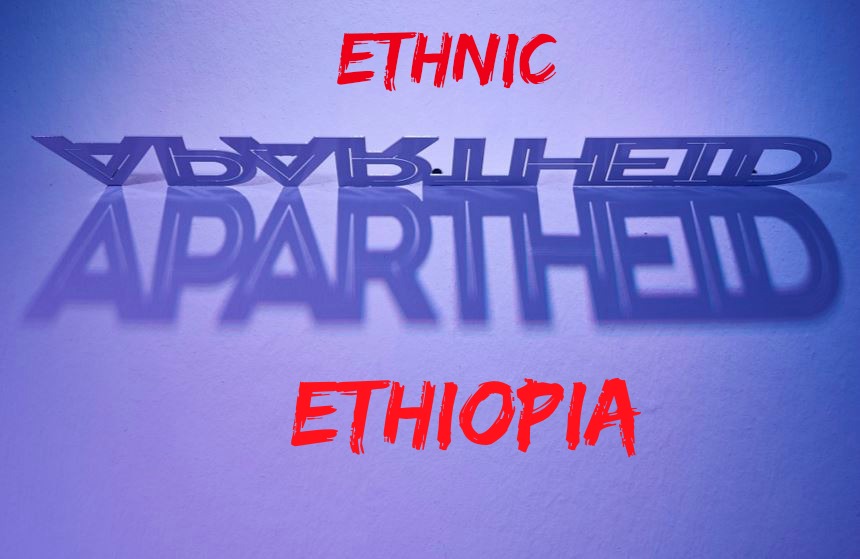The Bantustanization (Kililistanization) of Ethiopia

Author’s Note: This is the second installment in a series of ongoing commentaries that I expect to post regularly under the rubric, “Ethnic Apartheid in Ethiopia”.
The twin aims of the series are: 1) to demonstrate beyond a shadow of doubt that the political system created and maintained by the Thugtatorship of the Tigrean People’s Liberation Front (T-TPLF) is a slightly kinder and gentler form of the racial apartheid system practiced by the white minority regime in South Africa before the establishment of black majority rule, and 2) to engage Ethiopia’s Cheetah (younger) Generation in broad and wide ranging conversation, debate and discussion necessary for the creation of the New Ethiopia cleansed of ethnic apartheid.
In the “Ethnic Apartheid in Ethiopia ” series, I aim to go beyond mere critical political and legal analysis and intellectual and academic examination of the objective political, social and economic conditions in Ethiopia under T-TPLF rule. Indeed, I aim to make a clarion call to Ethiopia’s Cheetah Generation: Ethiopia is in the palms of your hands. You have the choice of holding Ethiopia in the palms of your hands with your fingers together firm, tight and strong and handle her like a precious jewel. You have the choice of letting loose your fingers and dropping her and watch her shatter like glass. You have the choice of holding each other hand in hand, clasping palm to palm and walking alongside her. You have the choice of clenching your fingers and palms into a fist of fury and defend her honor and glory. My clarion call is, Ethiopia is in your hands; but “Ethiopia shall soon stretch out her hands unto God.”
My question to Ethiopia’s Cheetah Generation
In my first commentary, I challenged Ethiopia’s youth to begin systematically and critically questioning the meaning of “ethnic federalism” imposed upon Ethiopia by the T-TPLF, currently classified as a terrorist group by the Global Terrorism Database. I sketched out the outlines of my preliminary arguments against “ethnic federalism” and exhorted Ethiopia’s Cheetah Generation to reject it wholly and consign it to the dustbin of history.
In this commentary, I continue my challenge to Ethiopia’s youth by providing them legal evidence to aid in their ongoing scrutiny of the bantustanization or kililistanization of Ethiopia by the T-TPLF into nine ethnically-based “kilils” or regional “states”.
I believe the problem of the first two decades of 21st Century Ethiopia is the problem of the ethnic line. It is an ethnic line conceived and gestated in the womb of the T-TPLF and birthed to inflict destruction and ruin in the Ethiopian body politics.
The problems of ethnic division and tribalism are not new to Ethiopia or Africa. Walter Rodney argued that even though ethnic differences exist on the African continent, they were not necessarily political differences. They were politicized by certain African elites who have created ethnic lines to aggrandize power and amass wealth for themselves and their cronies.
The T-TPLF has created ethnic lines and kilils to aggrandize power and amass wealth for itself and its cronies. What is curiously strange is the T-TPLF’s use of ethnic lines in the same way the minority white apartheid regime used race and ethnicity to divide South African society and dominate the political system and subjugate the majority black African population by controlling and manipulating ownership, access and use of land.
Like the minority white apartheid regime in South Africa, the T-TPLF has built its political and economic power by literally owning all of the land in the country (Art. 40 of the T-TPLF constitution) and by totally controlling political power (the T-TPLF “won” the May 2015 election by 100 percent and reinforces its dictatorial rule by the barrel of the gun), monopolizing the private sector (T-TPLF controlled interlocking syndicates maintain complete monopoly over the economy) and parceling out employment, educational and other opportunities in exchange for political support and allegiance.
In 2016, the problem of Ethiopia is the problem of T-TPLF domination, subjugation and exploitation of the majority population by using ethnicity both as a political line that cannot be crossed and as a political fulcrum on which all things political, social, economic and cultural pivot.
The land and “legal” basis of South Africa’s racial apartheid system
At the foundation of South Africa’s racial/ethnic apartheid system was land. Ownership of land. Use of land. Occupation of land. Control of land. Unequal distribution of land. Monopoly of nearly 90 percent of the land by white minority farmers. Land grabs by whites and evictions and displacement of the black majority population. Under-compensation for illegally expropriated land. Dispossession of ancestral lands of Black South Africans. Thus, the keystone and pillar of minority white apartheid rule in South Africa was the unequal distribution of land and the consequent dispossession and economic disempowerment of the black majority by a variety of “legal” means.
The foundation for apartheid was laid down in the Natives’ Land Act, 1913 (Act No. 27 of 1913), decades before its official introduction in 1948. The Land Act became the principal legal tool for the systematic land dispossession of the Black majority by the white minority controlled State. The Act reinforced by subsequent legislation severely restricted the black African majority’s right to own land only in the “native reserves”, which constituted only 14 per cent of the total area of South Africa while the Whites owned 87 per cent.
The Group Areas Act Group Areas Act 1950 later consolidated by Group Areas Act 36 of 1966 formalized residential segregation by race in South Africa. This Act empowered the minority white regime to designate rural and urban land for exclusive ownership by whites, colored, and Indians, but made no legal provisions for land to be owned or occupied exclusively by the majority black population. But black South Africans who were specifically prohibited from occupying or owning land in areas designated for other groups.
The Population Registration Act of 1950 (PRA) of South Africa required that each inhabitant of South Africa be classified and recorded in the population register according to their race and ethnic group. That PRA became the foundation of the apartheid system which served to segregate and facilitate political and economic discrimination against the majority black population and other non-whites. (The Afrikaans word “apartheid” literally means “separateness”, from Dutch apart “separate” plus –heid, equivalent of -hood. Under the PRA, individuals were classified as “native”, “coloured”, “Asian” or “white”. Identity documents were the main tool used to implement the strict racial segregation and subjugation.
The Bantu Authorities Act of 1951 (BAA) (Act No. 68 of 1951; subsequently renamed the Black Authorities Act, 1951) was enacted to grant authority to traditional tribal leaders in their homelands. The BAA defined “Black areas”, “chiefs”, “tribal authorities” and established their powers, functions, duties and jurisdictions. The BAA created the legal basis for self-determination of the various ethnic and linguistic tribes into traditional homeland reserve areas and established tribal, regional and territorial authorities. The Bantu Authorities Act, 1951(“Black Authorities Act, 1951”) created the legal basis for the deportation of blacks into designated homeland reserve areas and established tribal, regional and territorial authorities.
The Group Areas Act of 1950 (as re-enacted in the Group Areas Act of 1966), divided South Africa into separate areas for whites and blacks and gave the government the power to forcibly remove people from areas not designated for their particular tribal and racial group. Under this Act, anyone living in the “wrong” area was deported to his/her tribal group homeland. The law also denied Africans the right to own land anywhere in South Africa and stripped them of all political rights. The lives of over 3.5 million people were destroyed by this law as black South Africans were forcibly deported and corralled like cattle in their tribal group bantustans.
The Promotion of Bantu Self-Government Act of 1959 (PBSA) (Act No 46) set up 8 (later expanded to 10) distinct “Bantu Homelands” out of the existing reserves, each with a degree of self-government based on a hierarchical system of headmen, chiefs, paramount chiefs, and territorial authorities in the black areas. The governments of the homelands were given limited powers of taxation, control public works,and issue licenses and adjudicate disputes. The central aim of the PBSA was to eventually grant independence to the homelands, expatriate them from South African citizenship and provide the white minority population virtual majority power. The Bantu Homelands Constitution Act, 1971 authorized the white minority regime to grant independence to any “Homeland” as determined by the South African apartheid government. The aim of the Act was clear: “It is the firm and irrevocable intention of the government to lead each nation to self-government and independence.” In other words, the “Homelands” act was designed to ultimately convert traditional tribal lands into “fully fledged independent states Bantustans” with the power of self-determination. In accordance with this Act, “independence” was eventually granted to Transkei, Bophuthatswana, Venda and Ciskei between 1976 and 1981.
The virulent white supremacist South African prime minister Hendrik Verwoerd in the early 1960s used the PRA to institutionalize a policy known as “separate development.” Apartheid was intended to be the policy road map by which the “Bantu Homelands” were to become a nation with their own homeland, or bantustan. The minority white regime had other political objectives in implementing its strategy of bantustanizing the majority black population. First, they calculated that by dividing the majority black Africans into smaller discrete populations they could divide and rule them. Second, they believed they could eliminate any practical possibility of black South African unity if they could succeed in creating a bantustanized ethnic identity in which black South Africans feel estranged against each other.
As a result of bantustanization, the minority white regime “reserved” some 14 percent of the land as homelands (bantustans) for black South Africans while keeping all of the fertile, mineral and urban areas for the whites. Nearly 90 percent of South Africa’s commercial farmland was in the hands of 50,000 white farmers or state. Politically, bantustanization would allow black South Africans homeland rights and freedoms, but outside their designated areas they were to be treated as outsiders. Black South Africans could be denied equality within South Africa proper if they were citizens of their own ethnically defined states rather than the Republic of South Africa.
South Africa’s racial/ethnic apartheid system was based on the white minority regime’s determination to control the land and through control of the land control the identity, citizenship, residence, political, social and economic rights of the majority black population. The identity of South Africans was determined principally by their relationship to the land. The minority whites owned all of the productive land and black South Africans virtually none.
The land and “legal” basis of T-TPLF’s ethnic apartheid system
The extraordinary act of genius by the T-TPLF is the creation of an ethnic apartheid system in its 1995 constitution by incorporating the essence of all of the apartheid laws and policies the white minority South African regime enacted over decades.
In the 1995 T-TPLF constitution, the drafters melded together land and ethnicity to create kililistans which replicate the essential political, social, economic and cultural dynamics of South Africa’s bantustans. In its Preamble, the T-TPLF constitution declares, “We, the Nations, Nationalities and Peoples of Ethiopia: Strongly committed, in full and free exercise of our right to self-determination…” In Article 8 (1), the T-TPLF constitution provides, “All sovereign power resides in the Nations, Nationalities and Peoples of Ethiopia.” In Article 39, the T-TPLF constitution guarantees, “Every Nation, Nationality and People in Ethiopia has an unconditional right to self-determination, including the right to secession.” Art. 47(2) “Nations, Nationalities and Peoples within the States enumerated in sub-Article 1 of this article have the right to establish, at any time, their own States.” Interestingly, the Republic of South Africa Constitution Act 110 of 1983 makes a similar declaration that it aims “To respect, to further and to protect the self-determination of population groups and peoples.”
Like South Africa’s Promotion of Bantu Self-Government Act of 1959 which created 8 (later expanded to 10) bantustans (black homelands), the T-TPLF’s constitution in Article 46 (2) creates kililistans (“kilils”) “delimited on the basis of the settlement patterns, language, identity, and consent of the peoples concerned.” Art. 47 created 9 “states” (kililistans) defined by “settlement patterns, language, identity”.
Like South Africa’s apartheid constitution and laws which gave to the apartheid state and minority white population total control over the land, the T-TPLF constitution in Article 40 (3) ensures that ownership of all land is in the T-TPLF state and T-TPLF cronies, supporters and compradors in the kililistans: “The right to ownership of rural and urban land, as well as of all natural resources, is exclusively vested in the State and in the peoples of Ethiopia. Land is a common property of the Nations, Nationalities and Peoples of Ethiopia and shall not be subject to sale or to other means of exchange.” Yet, the T-TPLF has been handing over hundreds of thousands of hectares of the most fertile land in the kililistans to shady fly-by-night “investors”. The Indian investor Karuturi a couple of months ago dared the T-TPLF to touch his “land-grabbed” territory the size of Wales in Gambella in Western Ethiopia and threatened to bring down the power of India on the TPLF thugs. Talk about chutzpah!
The kililistanization of Ethiopia has enabled the T-TPLF regime and its cronies to become the political and economic masters of the majority Ethiopian population. The T-TPLF has been able to do in 25 years what the white minority apartheid regime took decades to accomplish. The T-TPLF has corralled the population of Ethiopia in to an open air prison with the T-TPLF jail keepers ruling and micromanaging the politics and economy of the country right down to the hamlets in the kililistans.
As I have often argued, the late Meles Zenawi, the chief architect of ethnic kililistans” like the virulent South African white supremacist Hendrik Verwoerd in the early 1960s, was driven by a “vision” of ethnic division in Ethiopia. For nearly two decades, Meles toiled ceaselessly to shred the very fabric of Ethiopian society, and sculpt a landscape balkanized into tribal, ethnic, linguistic and regional enclaves.” Meles crafted a constitution based entirely on ethnicity and tribal affiliation as the basis for political organization.
In much the same way the white minority apartheid regime physically moved black South Africans from one native area to another, the T-TPLF has taken from the same playbook and forcefully evicted members of the “Amhara” ethnic group from Benishangul-Gumuz (one of the nine kililistans) in a criminal act of de facto ethnic cleansing. The late Meles Zenawi justified the forced expulsion of tens of thousands of Amharas from Southern Ethiopia stating, “… By coincidence of history, over the past ten years numerous people — some 30,000 sefaris (squatters) from North Gojam – have settled in Benji Maji (BM) zone [in Southern Ethiopia]. In Gura Ferda, there are some 24,000 sefaris.” Through “villagization” programs, indigenous populations have been forced of their ancestral lands in Gambella, Benishangul and the Oromo River Valley and their land auctioned off to voracious multinational agribusinesses.
The perils and untenability of T-TPLF’s kililistans have been documented in a landmark study by International Crises Group (ICG). In “Ethiopia: Ethnic Federalism and Its Discontents”, the ICG warned of the problems engendered by “ethnic federalism” (kililistans) in “redefine[ing] citizenship, politics and identity on ethnic grounds.” The study argues that “ethnic federalism” has resulted in “an asymmetrical federation that combines populous regional states like Oromiya and Amhara in the central highlands with sparsely populated and underdeveloped ones like Gambella and Somali.” Moreover, “ethnic federalism” has created “weak regional states”, “empowered some groups” and failed to resolve the “national question”. Aggravating the underlying situation has been the Meles dictatorship’s failure to promote “dialogue and reconciliation” among groups in Ethiopian society, further fueling “growing discontent with the EPRDF’s ethnically defined state and rigid grip on power and fears of continued inter-ethnic conflict.”
The ICG report makes it clear that in the long term “ethnic federalism” could trigger an implosion and disintegration of the Ethiopian nation. The late T-TPLF messiah Meles Zenawi once boasted that when he took power Ethiopia “was teetering on the edges, the country was on the brink of total disintegration.” He argued that “Every analyst worth his salt was suggesting that Ethiopia will go the way of Yugoslavia or the Soviet Union. Since then, Ethiopia has not gone the way of Yugoslavia, Somalia, Congo or even the way of Eritrea.”
Meles, the little messiah, always overrated himself. He liked to trot out all sorts of boogeymen to scare the population into submission. The truth of the matter is that ethnic balkanization, fragmentation, segregation and polarization are the tools of trade used by the Meles regime to cling to power while lining their pockets. In a genuine federalism, the national government is the creature of the subnational governments. In Ethiopia, the “kilil” (regional) “governments” are creatures and handmaidens of the T-TPLF. In a genuine federalism, the national government is entrusted with limited and enumerated powers for the purpose of effectuating the common purposes of the subnational “governments”. In Ethiopia, the powers of the T-TPLF are vast and unlimited; and there are no barriers to its usurpatory powers in the kililistans which it exercises at will. In the T-TPLF kililistan system, there are no safeguards against encroachment on the rights and liberties of the people by the T-TPLF or T-TPLF comprador kililistan “governments”. Simply stated, the T-TPLF’s policy of kililistanization has become a recipe for T-TPLF tyranny (T-TPLF-T). Kililism has become the creed for secessionists in the name of self-determination.
The similarities between the minority white apartheid regime and the T-TPLF ethnic apartheid regime are too numerous to list. The T-TPLF exercises complete monopoly over political power, representation and decision-making in much the same way as the white minority apartheid National Party. The T-TPLF has sought to portray any critic of its kililistan policy as “Amhara” nationalists (so-called neftegna, soldier-settlers) from a bygone era whose aim is to reestablish Amhara hegemony over other ethnic groups in Ethiopia. The T-TPLF has sought to characterize other opponents as extremists and terrorists bent on creating civil war Rwanda-style interahamwe. The minority white apartheid regime called its opponents “communist terrorists”.
The T-TPLF functions in the same way as the apartheid minority white South African regime. The T-TPLF state within the state makes all of the critical decisions. When Meles was alive the state within the state included Meles’ trusted buddies from the bush and yes-men who fed at at the cash trough he built since taking power. Like the apartheid minority white South African regime, the T-TPLF allows independent decision-making in the kililsitans but in reality all decisions are centralized and predetermined in the T-TPLF state within the state. T-TPLF security and intelligence officers operate like a state within a state in the kililistans just like in South Africa’s bantustans.
Like the bantustans under the apartheid minority white South African regime, the T-TPLF uses patronage and public resources to control the kililistans who are so dependent on the T-TPLF for land and resources that they are incapable of challenging the T-TPLF. The T-TPLF security apparatus completely overwhelms local authorities in the kililistans. In fact, in areas considered politically unstable T-TPLF security and military operatives function independent of kililistan authorities just as was the case in the bantustans in apartheid South Africa. TPLF officers operate the security and military operations in the kililistans. Any official who does not tow the T-TPLF line in the kililistans is kicked out of power and often charged with corruption.
Like the the apartheid minority white South African regime in the bantustans, the T-TPLF in the kililistans uses a variety of strategies to maintain control. It uses the party structure in the make believe “EPRDF” party to manipulate, rubberstamp and implement its policies. Because the kililistans are dependent on the T-TPLF for budgetary and other support, the T-TPLF uses its “power of the purse” to keep them in line and tow the T-TPLF line.
Like their apartheid counterparts, the T-TPLF assumes the ethno-linguistic groups it created are monolithic and homogeneous. They were neither homogenous nor clearly “delimited on the basis of simplistic settlement patterns, language, identity.” The people of Ethiopia are of mixed parenthood, culture and identity. The whole fiction of “nations, nationalities and peoples” may be appealing to Stalinist T-TPLFers but it simply did not reflect the reality of historic ethnic heterogeneity and diversity. The T-TPLF’s conception of ethnicity is simply inconsistent with the historical reality.
A few weeks ago, Prince Mengesha Seyoum, Governor of Tigray until the monarchy was abolished in 1974, debunked the T-TPLF’s kililistan arrangement in the north of Ethiopia. Prince Mengesha rejected the T-TPLF’s kililistanization of Wolkait Tsegede in Tigray. In other words, in the Wolkait Tsegede kililistization the T-TPLF calculatedly created a bogus homeland which failed to meet its own constitutionally declared criteria of “settlement patterns, language, identity, and consent of the peoples concerned”.
The kililistanization of Ethiopia is a diabolical plan by the T-TPLF to divide Ethiopians along ethnic lines for the sole purpose of facilitating T-TPLF rule in Ethiopia and prolonging T-TPLF’s tenure in power. Prof. Ted Vestal, the distinguished Ethiopianist, in his article, “Human Rights Abuses in ‘Democratic’ Ethiopia: Government Sponsored Ethnic Hatred”, perfectly summarized T-TPLF’s kililistan strategy:
Another aspect of the EPRDF’s [the bogus organizational shell used by the TPLF to project an image of pluralism] strategy is to establish a governing system of ethnic federalism emphasizing rights of ‘nations, nationalities, and peoples.’ This high-sounding principle, cribbed from Lenin, is more Machiavellian than Wilsonian however. If the outnumbered Tigrayans who direct the EPRDF/FDRE can keep other ethnic groups divided and roiled against each other in ethno-xenophobias or content to manage affairs in their own limited bailiwicks, then larger matters can be subsumed by the one governing party. Thus, what the EPRDF views as the false ideology of nationalism for a ‘Greater Ethiopia’ can be kept in check and its proponents divided and conquered.
Ethiopia’s Cheetah Generation: “Ethiopia is in your hands.”
Gerry Spence, one of America’s great trial lawyers once delivered a closing statement in a criminal case which captures my innermost feelings about what Ethiopia’s youth can and must do for themselves and their country. Spence argued:
Ladies and gentlemen I am about to leave you, but before I leave you I’d like to tell you a story about a wise old man and a smart-alec boy. The smart-alec boy had a plan, he wanted to show up the wise old man, to make a fool of him. The smartalec boy had caught a bird in the forest. He had him in his hands. The little bird’s tail was sticking out. The bird is alive in his hands. The plan was this: He would go up to the old man and he would say, “Old man, what do I have in my hands?” The old man would say, “You have a bird, my son.” Then the boy would say, “Old man, is the bird alive or is it dead?” If the old man said that the bird was dead, he would open up his hands and the bird would fly off free, off into the trees, alive, happy. But if the old man said the bird was alive, he would crush it and crush it in his hands and say, “See, old man, the bird is dead.” So, he walked up to the old man and said, “Old man, what do I have in my hands?” The old man said, “You have a bird, my son.” He said, “Old man, is the bird alive or is it dead?” And the old man said, “The bird is in your hands, my son.”
I say to Ethiopia’s youth, Ethiopia is in your hands. Only you know if she is alive or dead or if she will be alive or dead. Only you can ensure she lives forever!
TO BE CONTINUED…







